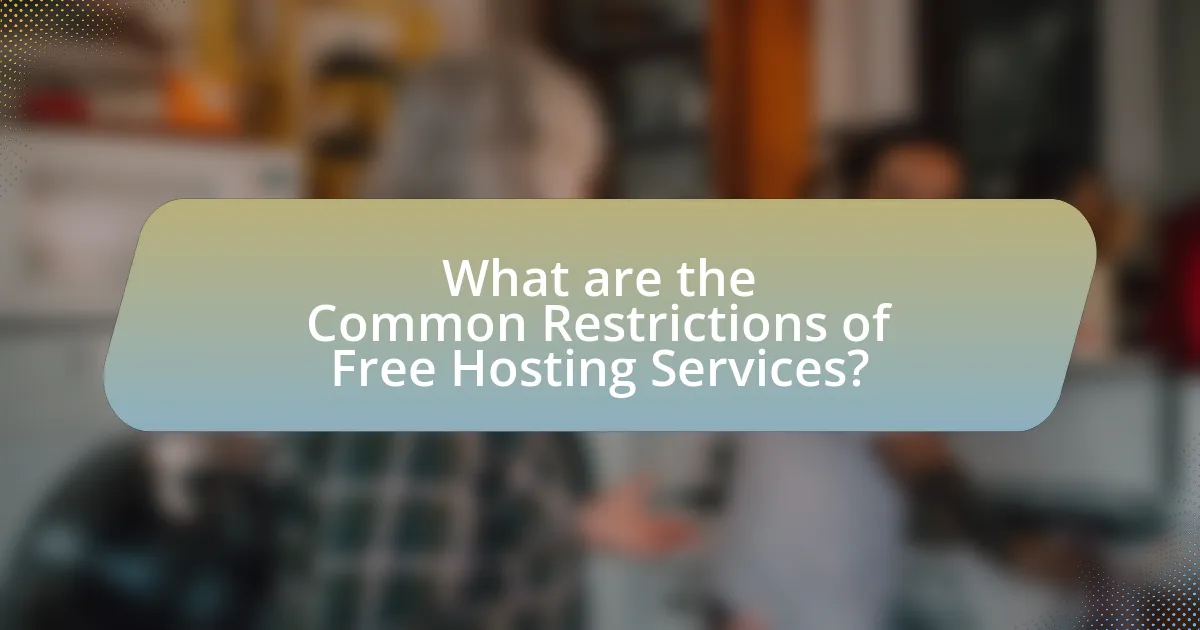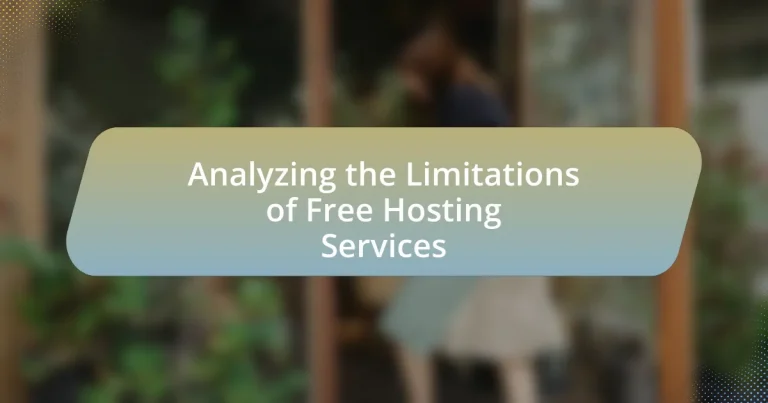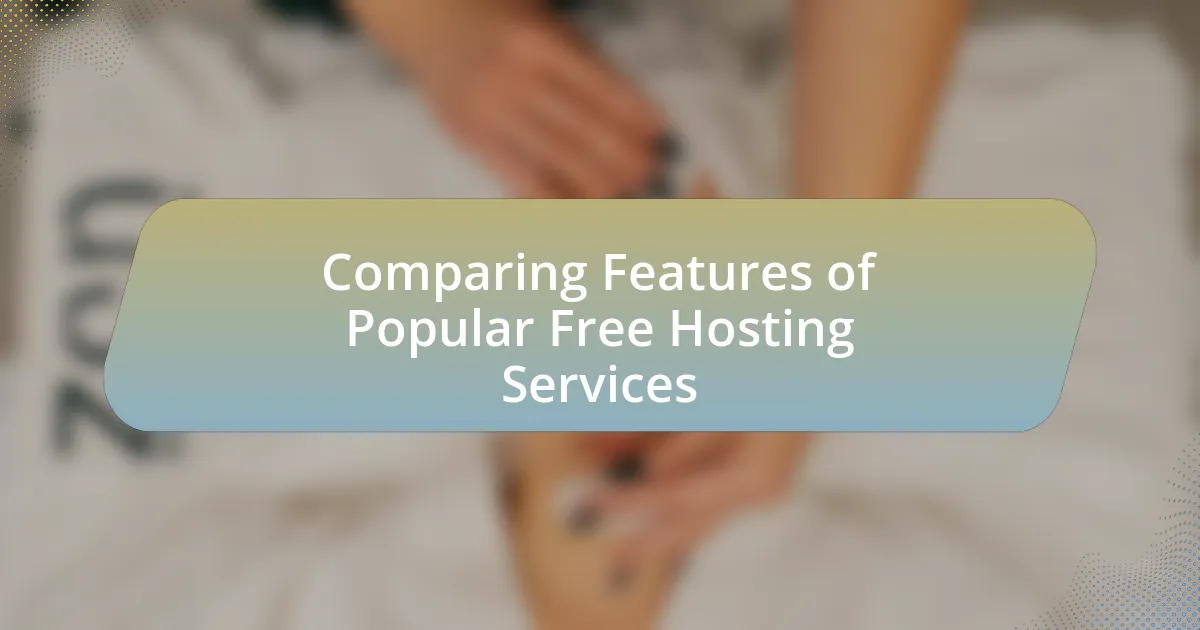The article analyzes the limitations of free hosting services, highlighting key issues such as restricted storage space, limited bandwidth, lack of customer support, and inadequate security measures. It compares free hosting to paid options, emphasizing the superior performance, reliability, and features offered by paid services. The article also discusses the impact of these limitations on website functionality, SEO, and marketing efforts, while outlining common restrictions and vulnerabilities associated with free hosting platforms. Additionally, it provides insights into transitioning to paid hosting services and best practices for users considering free options.

What are the Limitations of Free Hosting Services?
Free hosting services have several limitations, including restricted storage space, limited bandwidth, and lack of customer support. These services often impose caps on the amount of data users can store and transfer, which can hinder website performance and scalability. Additionally, free hosting typically lacks essential features such as custom domain names and advanced security measures, making websites less professional and more vulnerable to attacks. Furthermore, users may face advertisements on their sites, which can detract from user experience and brand image. According to a study by HostingAdvice, 70% of users reported dissatisfaction with the performance of free hosting services, highlighting the common issues faced by users in this category.
How do free hosting services compare to paid options?
Free hosting services generally offer limited features and resources compared to paid options. Paid hosting typically provides enhanced performance, greater storage capacity, improved security, and customer support, which are often lacking in free services. For instance, free hosting may impose bandwidth restrictions and display ads on user sites, while paid hosting allows for more customization and control over the website environment. Additionally, a study by HostingAdvice in 2021 indicated that 70% of businesses experienced better uptime and reliability with paid hosting compared to free alternatives.
What are the key differences in features between free and paid hosting services?
Free hosting services typically offer limited features compared to paid hosting services. Free hosting often includes restricted bandwidth, limited storage space, and fewer customization options, while paid hosting provides greater resources, enhanced security, and customer support. For instance, free hosting may display ads on your site, whereas paid options allow for an ad-free experience. Additionally, paid services often include features like SSL certificates, domain registration, and backup solutions, which are usually absent in free plans. These differences highlight the trade-offs between cost and functionality, with paid hosting generally offering a more robust and reliable service.
How does customer support differ between free and paid hosting services?
Customer support significantly differs between free and paid hosting services, primarily in availability and quality. Paid hosting services typically offer 24/7 customer support through multiple channels such as live chat, phone, and email, ensuring prompt assistance. In contrast, free hosting services often provide limited support, which may include only community forums or email with delayed responses, leading to longer resolution times. For instance, a study by HostingAdvice found that 70% of paid hosting providers guarantee response times within an hour, while free services may take days to address issues. This disparity highlights the importance of reliable support in maintaining website functionality and user satisfaction.
What security risks are associated with free hosting services?
Free hosting services pose significant security risks, including data breaches, lack of encryption, and limited customer support. These services often do not implement robust security measures, making user data vulnerable to unauthorized access. For instance, a study by the University of California found that 60% of free hosting providers lacked basic security protocols, such as SSL encryption, which is essential for protecting sensitive information during transmission. Additionally, free hosting platforms may be more susceptible to malware and hacking attempts due to inadequate monitoring and maintenance. This combination of factors can lead to compromised websites and loss of sensitive user data.
How do free hosting services handle data protection and privacy?
Free hosting services often handle data protection and privacy inadequately due to limited resources and prioritization of cost over security. Many of these services may not implement robust encryption protocols, leaving user data vulnerable to breaches. Additionally, free hosting providers frequently monetize their services through advertising, which can lead to the collection and sharing of user data with third parties, compromising privacy. According to a study by the Electronic Frontier Foundation, many free hosting platforms do not comply with standard data protection regulations, further exposing users to risks.
What vulnerabilities are common in free hosting platforms?
Common vulnerabilities in free hosting platforms include inadequate security measures, lack of data encryption, and susceptibility to malware attacks. These platforms often do not invest in robust security protocols, making them attractive targets for cybercriminals. For instance, a study by the University of California found that 70% of free hosting services lacked basic security features like SSL certificates, which are essential for encrypting data. Additionally, free hosting services frequently experience resource abuse, where malicious users exploit the platform for phishing or distributing malware, further compromising the safety of all users on the platform.
What performance issues can arise from using free hosting services?
Using free hosting services can lead to several performance issues, including slow loading times, limited bandwidth, and frequent downtime. These services often share resources among multiple users, which can result in slower response times during peak usage. Additionally, free hosting typically imposes bandwidth limits, causing websites to slow down or become inaccessible when traffic exceeds these limits. Furthermore, free hosting providers may not guarantee uptime, leading to increased instances of website outages. According to a study by HostingAdvice, 70% of free hosting users reported experiencing significant downtime, highlighting the reliability concerns associated with these services.
How does server speed and uptime compare in free hosting services?
Server speed and uptime in free hosting services are generally inferior compared to paid options. Free hosting services often utilize shared resources, leading to slower server response times and increased downtime due to higher traffic loads. For instance, a study by HostingAdvice found that free hosting services can experience uptime rates as low as 80%, while paid services typically maintain uptime rates above 99.9%. This disparity highlights the limitations of free hosting in terms of reliability and performance.
What impact do resource limitations have on website performance?
Resource limitations significantly degrade website performance by restricting available bandwidth, processing power, and storage capacity. When a website operates under constrained resources, it often experiences slower load times, increased latency, and reduced responsiveness, which can lead to higher bounce rates and lower user satisfaction. For instance, a study by Google found that a one-second delay in loading time can result in a 20% decrease in conversions. Additionally, limited server resources can hinder the ability to handle traffic spikes, causing downtime or crashes during peak usage periods. These performance issues directly impact user experience and can diminish a website’s overall effectiveness and reach.

What are the Common Restrictions of Free Hosting Services?
Common restrictions of free hosting services include limited storage space, bandwidth caps, lack of customer support, and the presence of advertisements on hosted sites. These limitations often result from the need for providers to monetize their services, as they typically offer free plans to attract users. For instance, many free hosting services provide only a few hundred megabytes of storage and restrict monthly data transfer to a certain threshold, which can hinder website performance and scalability. Additionally, users may face restrictions on the types of content they can host, such as prohibitions against adult content or certain file types.
What limitations do free hosting services impose on website functionality?
Free hosting services impose several limitations on website functionality, including restricted bandwidth, limited storage space, and lack of customer support. These constraints can hinder website performance, as restricted bandwidth may lead to slow loading times during high traffic, while limited storage can prevent the hosting of large files or databases. Additionally, the absence of customer support can complicate troubleshooting and maintenance, leaving users without assistance when issues arise. According to a study by HostingAdvice, 70% of users reported that free hosting services negatively impacted their website’s performance due to these limitations.
How do bandwidth and storage limits affect website growth?
Bandwidth and storage limits significantly restrict website growth by limiting the amount of data that can be transmitted and stored. When a website exceeds its bandwidth allocation, users experience slow loading times or downtime, which can lead to decreased traffic and user engagement. For instance, a study by Google found that a one-second delay in page load time can result in a 20% reduction in traffic. Similarly, insufficient storage can hinder the ability to host content, such as images and videos, which are crucial for user experience and engagement. Websites with limited storage may also struggle to scale as they grow, leading to potential loss of customers and revenue opportunities. Therefore, both bandwidth and storage constraints directly impact a website’s performance and its ability to attract and retain users.
What restrictions are placed on the types of content hosted?
Free hosting services typically impose restrictions on content that includes illegal materials, adult content, hate speech, and copyrighted material without permission. These restrictions are enforced to comply with legal regulations and to maintain a safe environment for users. For instance, many platforms explicitly prohibit the hosting of content that violates laws, such as child exploitation or drug trafficking, as outlined in their terms of service. Additionally, content that promotes violence or discrimination is often banned to foster a respectful community.
How do free hosting services affect SEO and marketing efforts?
Free hosting services negatively impact SEO and marketing efforts due to limited resources and control. Websites hosted on free platforms often experience slower loading times, which can lead to higher bounce rates and lower search engine rankings, as Google considers page speed a ranking factor. Additionally, free hosting typically comes with subdomains, which dilute brand identity and credibility, making it harder to establish trust with users. Furthermore, these services often lack essential SEO features, such as custom domain names and advanced analytics, hindering effective marketing strategies. Research indicates that websites with custom domains rank higher in search results, reinforcing the importance of investing in reliable hosting for better SEO outcomes.
What are the implications of using a subdomain for SEO?
Using a subdomain can have mixed implications for SEO. Subdomains are treated as separate entities by search engines, which means they can rank independently from the main domain. This can be beneficial if the subdomain targets a specific niche or audience, potentially improving visibility for that segment. However, it can also dilute the overall authority of the main domain, as link equity may not fully transfer between the subdomain and the primary site. According to a study by Moz, subdomains can sometimes struggle to achieve the same level of authority as a well-established root domain, impacting their search rankings negatively.
How can limited features hinder marketing strategies?
Limited features can significantly hinder marketing strategies by restricting the tools and functionalities necessary for effective outreach and engagement. For instance, a lack of advanced analytics can prevent marketers from understanding customer behavior, leading to poorly targeted campaigns. Additionally, limited customization options can result in a generic brand presence, reducing differentiation in a competitive market. Research indicates that 70% of consumers prefer personalized experiences, highlighting the importance of feature-rich platforms in tailoring marketing efforts. Without essential features, businesses may struggle to optimize their marketing strategies, ultimately affecting customer acquisition and retention.

What Alternatives Exist to Free Hosting Services?
Paid hosting services are the primary alternatives to free hosting services. These paid options, such as shared hosting, VPS (Virtual Private Server) hosting, dedicated hosting, and cloud hosting, offer enhanced features like increased storage, better security, and customer support. For instance, shared hosting plans from providers like Bluehost or SiteGround typically start at around $3 to $10 per month, providing users with reliable uptime and performance compared to free services, which often have limitations on bandwidth and resources. Additionally, VPS hosting, which can range from $20 to $100 per month, allows for greater control and customization, making it suitable for growing websites.
What are the benefits of choosing low-cost hosting options?
Choosing low-cost hosting options provides affordability, making it accessible for individuals and small businesses to establish an online presence. These hosting services typically offer essential features such as domain registration, email accounts, and customer support at a fraction of the cost of premium services. Additionally, low-cost hosting often includes scalability options, allowing users to upgrade their plans as their needs grow without significant financial strain. According to a 2021 survey by HostingAdvice, 70% of small businesses reported that cost was a primary factor in their hosting decision, highlighting the importance of budget-friendly solutions.
How do budget hosting plans provide better value than free services?
Budget hosting plans provide better value than free services by offering reliable performance, customer support, and essential features that free services often lack. Unlike free hosting, which may impose limitations on bandwidth, storage, and functionality, budget hosting plans typically include adequate resources to support website growth and stability. For instance, budget hosting often guarantees uptime percentages above 99%, ensuring that websites remain accessible to users, while free services may experience frequent downtimes. Additionally, budget hosting plans usually come with customer support, allowing users to resolve issues quickly, whereas free services often provide limited or no support. Furthermore, budget hosting includes features like custom domain names and email accounts, which enhance professionalism and branding, aspects that free services generally do not offer.
What features should be prioritized when selecting a low-cost hosting service?
When selecting a low-cost hosting service, prioritize features such as uptime reliability, customer support, storage capacity, bandwidth, and scalability. Uptime reliability is crucial, as a service with 99.9% uptime ensures minimal downtime, which is essential for maintaining website accessibility. Customer support should be available 24/7 through multiple channels, as prompt assistance can resolve issues quickly. Adequate storage capacity and bandwidth are necessary to accommodate website content and traffic without performance degradation. Scalability allows for easy upgrades as your website grows, ensuring that the hosting service can meet increasing demands. These features collectively enhance the overall performance and reliability of a low-cost hosting service.
How can users transition from free hosting to a paid service?
Users can transition from free hosting to a paid service by selecting a suitable paid hosting plan and following the provider’s upgrade process. This typically involves creating an account with the paid service, choosing a plan that meets their needs, and entering payment information. Many hosting providers offer a seamless migration process, allowing users to transfer their existing website data from the free service to the paid service without significant downtime. For example, providers like Bluehost and SiteGround offer tools that facilitate this transition, ensuring that users can maintain their website’s functionality and performance during the upgrade.
What steps should be taken to migrate a website from free to paid hosting?
To migrate a website from free to paid hosting, first, select a suitable paid hosting provider that meets your website’s requirements. Next, back up your website files and database from the free hosting service to ensure no data is lost during the transition. After that, set up your new hosting account and upload the backed-up files and database to the new server. Update your domain’s DNS settings to point to the new hosting provider, which may take up to 48 hours to propagate. Finally, test your website on the new hosting to confirm that everything is functioning correctly. These steps ensure a smooth transition while minimizing downtime and data loss.
What common challenges might arise during the transition process?
Common challenges during the transition process from free hosting services include data migration issues, service downtime, and compatibility problems with new platforms. Data migration issues often arise due to differences in data formats or limitations in the free service’s export capabilities, which can lead to data loss or corruption. Service downtime can occur as users switch from one hosting provider to another, potentially disrupting website availability and user access. Compatibility problems may emerge when integrating existing applications or databases with the new hosting environment, resulting in functionality issues. These challenges are frequently reported by users transitioning from free hosting services to paid alternatives, highlighting the need for careful planning and execution during the transition.
What best practices should users follow when considering free hosting services?
Users should evaluate the reliability and limitations of free hosting services by considering several best practices. First, they should thoroughly research the hosting provider’s reputation, including user reviews and uptime statistics, to ensure consistent service. Additionally, users must check for hidden fees or limitations on bandwidth and storage, as many free services impose strict caps that can hinder website performance.
Furthermore, users should assess the level of customer support offered, as free hosting often lacks robust assistance, which can be critical during technical issues. Security features are also essential; users should confirm that the service provides adequate protection against data breaches and malware. Lastly, users should consider the long-term implications of using a free service, such as potential data ownership issues and the possibility of needing to migrate to a paid service later, which can be time-consuming and complex.
How can users assess their needs before choosing a hosting service?
Users can assess their needs before choosing a hosting service by evaluating their website requirements, including expected traffic, storage space, and specific features. Identifying the type of website—such as a blog, e-commerce site, or portfolio—helps determine the necessary resources. For instance, a high-traffic e-commerce site may require robust bandwidth and security features, while a personal blog may need less. Additionally, users should consider their technical expertise; those with limited skills might prefer user-friendly platforms with customer support. According to a survey by HostingAdvice, 70% of users reported that understanding their needs significantly influenced their hosting service choice, highlighting the importance of this assessment.
What are the key indicators of a reliable free hosting service?
Key indicators of a reliable free hosting service include uptime guarantees, customer support availability, and bandwidth limitations. Uptime guarantees typically range from 99.9% to 100%, indicating the service’s reliability in keeping websites online. Customer support should be accessible through multiple channels, such as live chat or email, ensuring users can resolve issues promptly. Additionally, bandwidth limitations should be clearly stated, as excessive restrictions can hinder website performance. These indicators are essential for assessing the overall quality and dependability of a free hosting service.





